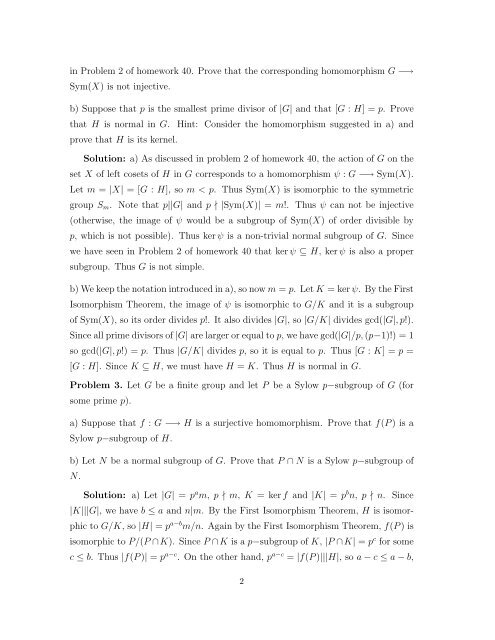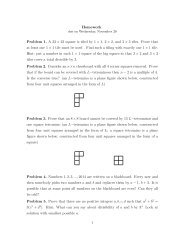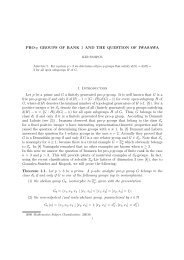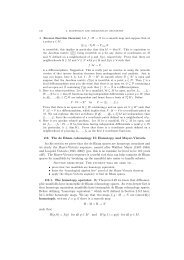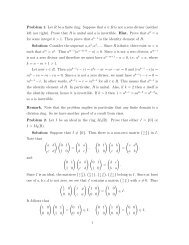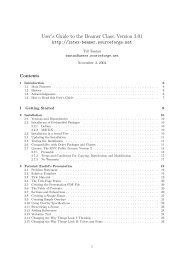Problem 1. a) Find all Sylow 2−subgroups of S 4. Hint. You may ...
Problem 1. a) Find all Sylow 2−subgroups of S 4. Hint. You may ...
Problem 1. a) Find all Sylow 2−subgroups of S 4. Hint. You may ...
Create successful ePaper yourself
Turn your PDF publications into a flip-book with our unique Google optimized e-Paper software.
in <strong>Problem</strong> 2 <strong>of</strong> homework 40. Prove that the corresponding homomorphism G −→<br />
Sym(X) is not injective.<br />
b) Suppose that p is the sm<strong>all</strong>est prime divisor <strong>of</strong> |G| and that [G : H] = p. Prove<br />
that H is normal in G. <strong>Hint</strong>: Consider the homomorphism suggested in a) and<br />
prove that H is its kernel.<br />
Solution: a) As discussed in problem 2 <strong>of</strong> homework 40, the action <strong>of</strong> G on the<br />
set X <strong>of</strong> left cosets <strong>of</strong> H in G corresponds to a homomorphism ψ : G −→ Sym(X).<br />
Let m = |X| = [G : H], so m < p. Thus Sym(X) is isomorphic to the symmetric<br />
group Sm. Note that p||G| and p ∤ |Sym(X)| = m!. Thus ψ can not be injective<br />
(otherwise, the image <strong>of</strong> ψ would be a subgroup <strong>of</strong> Sym(X) <strong>of</strong> order divisible by<br />
p, which is not possible). Thus kerψ is a non-trivial normal subgroup <strong>of</strong> G. Since<br />
we have seen in <strong>Problem</strong> 2 <strong>of</strong> homework 40 that kerψ ⊆ H, kerψ is also a proper<br />
subgroup. Thus G is not simple.<br />
b) We keep the notation introduced in a), so now m = p. Let K = kerψ. By the First<br />
Isomorphism Theorem, the image <strong>of</strong> ψ is isomorphic to G/K and it is a subgroup<br />
<strong>of</strong> Sym(X), so its order divides p!. It also divides |G|, so |G/K| divides gcd(|G|,p!).<br />
Since <strong>all</strong> prime divisors <strong>of</strong> |G| are larger or equal to p, we have gcd(|G|/p, (p−1)!) = 1<br />
so gcd(|G|,p!) = p. Thus |G/K| divides p, so it is equal to p. Thus [G : K] = p =<br />
[G : H]. Since K ⊆ H, we must have H = K. Thus H is normal in G.<br />
<strong>Problem</strong> 3. Let G be a finite group and let P be a <strong>Sylow</strong> p−subgroup <strong>of</strong> G (for<br />
some prime p).<br />
a) Suppose that f : G −→ H is a surjective homomorphism. Prove that f(P) is a<br />
<strong>Sylow</strong> p−subgroup <strong>of</strong> H.<br />
b) Let N be a normal subgroup <strong>of</strong> G. Prove that P ∩ N is a <strong>Sylow</strong> p−subgroup <strong>of</strong><br />
N.<br />
Solution: a) Let |G| = p a m, p ∤ m, K = kerf and |K| = p b n, p ∤ n. Since<br />
|K|||G|, we have b ≤ a and n|m. By the First Isomorphism Theorem, H is isomor-<br />
phic to G/K, so |H| = p a−b m/n. Again by the First Isomorphism Theorem, f(P) is<br />
isomorphic to P/(P ∩K). Since P ∩K is a p−subgroup <strong>of</strong> K, |P ∩K| = p c for some<br />
c ≤ b. Thus |f(P)| = p a−c . On the other hand, p a−c = |f(P)|||H|, so a − c ≤ a − b,<br />
2


